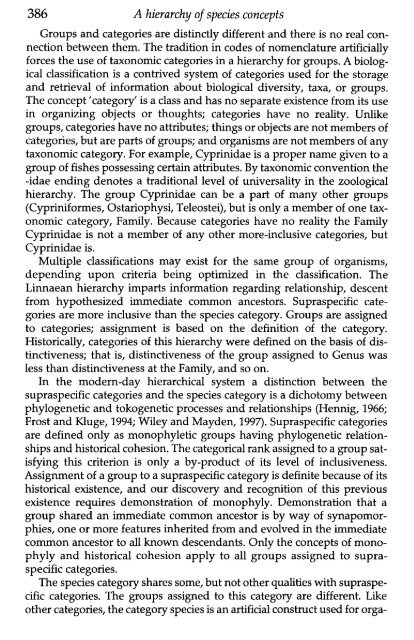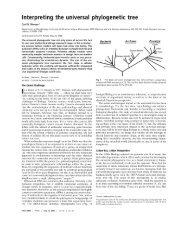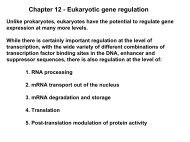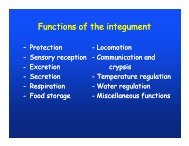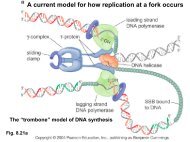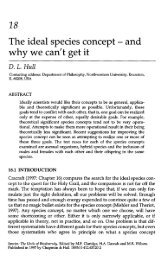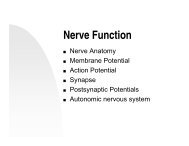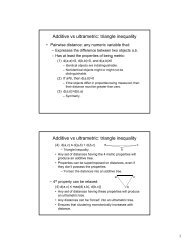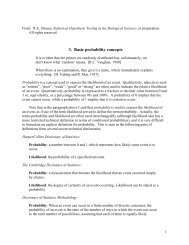Mayden, 1997 - Texas Tech University
Mayden, 1997 - Texas Tech University
Mayden, 1997 - Texas Tech University
Create successful ePaper yourself
Turn your PDF publications into a flip-book with our unique Google optimized e-Paper software.
386 A hierarchy of species conceptsGroups and categories are distinctly different and there is no real connectionbetween them. The tradition in codes of nomenclature artificiallyforces the use of taxonomic categories in a hierarchy for groups. A biologicalclassification is a contrived system of categories used for the storageand retrieval of information about biological diversity, taxa, or groups.The concept'category' is a class and has no separate existence from its usein organizing objects or thoughts; categories have no reality. Unlikegroups, categories have no attributes; things or objects are not members ofcategories, but are parts of groups; and organisms are not members of anytaxonomic category. For example, Cyprinidae is a proper name given to agroup of fishes possessing certain attributes. By taxonomic convention the-idae ending denotes a traditional level of universality in the zoologicalhierarchy. The group Cyprinidae can be a part of many other groups(Cypriniformes, Ostariophysi, Teleostei), but is only a member of one taxonomiccategory, Family. Because categories have no reality the FamilyCyprinidae is not a member of any other more-inclusive categories, butCyprinidae is.Multiple classifications may exist for the same group of organisms,depending upon criteria being optimized in the classification. TheLinnaean hierarchy imparts information regarding relationship, descentfrom hypothesized immediate common ancestors. Supraspecific categoriesare more inclusive than the species category. Groups are assignedto categories; assignment is based on the definition of the category.Historically, categories of this hierarchy were defined on the basis of distinctiveness;that is, distinctiveness of the group assigned to Genus wasless than distinctiveness at the Family, and so on.In the modern-day hierarchical system a distinction between thesupraspecific categories and the species category is a dichotomy betweenphylogenetic and tokogenetic processes and relationships (Hennig, 1966;Frost and Kluge, 1994; Wiley and <strong>Mayden</strong>, <strong>1997</strong>). Supraspecific categoriesare defined only as monophyletic groups having phylogenetic relationshipsand historical cohesion. The categorical rank assigned to a group satisfyingthis criterion is only a by-product of its level of inclusiveness.Assignment of a group to a supraspecific category is definite because of itshistorical existence, and our discovery and recognition of this previousexistence requires demonstration of monophyly. Demonstration that agroup shared an immediate common ancestor is by way of synapomorphies,one or more features inherited from and evolved in the immediatecommon ancestor to all known descendants. Only the concepts of monophylyand historical cohesion apply to all groups assigned to supraspecificcategories.The species category shares some, but not other qualities with supraspecificcategories. The groups assigned to this category are different. Likeother categories, the category species is an artificial construct used for orga-


